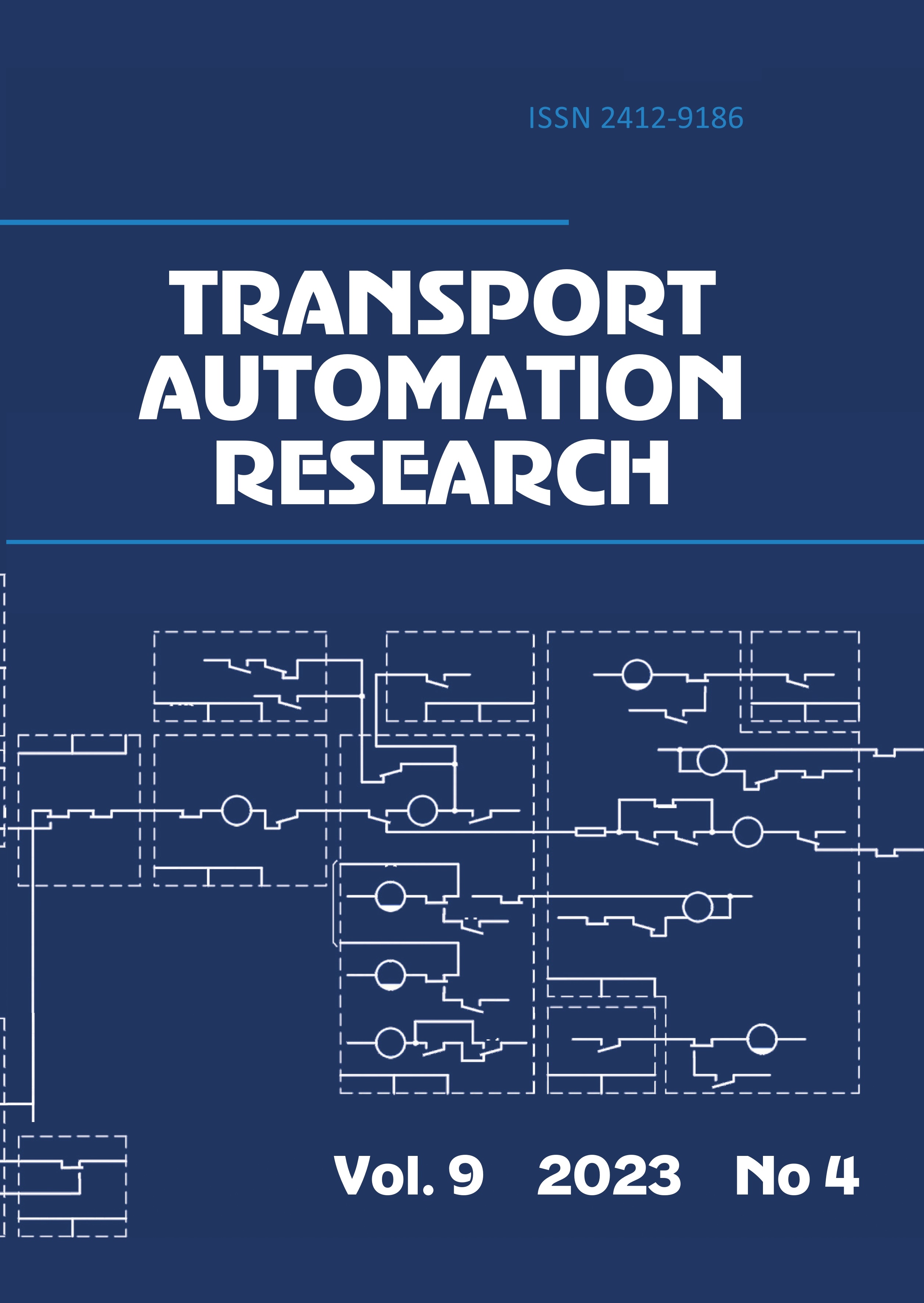Russian Federation
Russian Federation
Russian Federation
Russian Federation
Russian Federation
Russian Federation
The purpose of the article is to present the results of developing a method for formalizing simulation models of railway automation and remote control systems as queuing systems with a rigidly regulated sequence of using service devices while processing streams of requests of various types. For the software implementation of simulation models with such properties, the GPSS World tool is traditionally used. The logical time formalization is proposed, and the concept of the proposed formalization of simulation models is formulated. Its main provisions include: the type of request is determined solely by the composition and sequence of occupation and release of servicing devices; the use of transaction parameters to organize their multiphase processing for each type of request; checking the value of Boolean functions for each procedure of processing requests for each type; the regulated time in the procedure of processing requests is considered as one of the many logical conditions of Boolean functions; logical and parametric description of the modeled system should be performed at the level of initial data without changing the text of the modeling program. Objects in GPSS World sufficient for implementing this concept have been identified. Using the selected objects, an alphabet has been compiled, and logical diagrams of modeling algorithms have been developed in the obtained alphabet. This serves as a demonstration of the application of the logical time concept for the formalization of simulation models of complex queuing systems. A GPSS program has been developed to confirm the possibility and feasibility of using the proposed method for formalizing simulation models of railway automation systems with a rigid structure.
railway automation and remote control systems, queuing systems with a rigid structure, simulation model, Boolean functions, model formalization, logical algo¬rithm schemes
1. Markov D. S., Konstantinova T. Yu., Lykov A. A. et al. Tekhnologiya imitatsionnogo modelirovaniya sistem zheleznodorozhnoy avtomatiki i telemekhaniki [Technology of simulation modeling of railway automation and telemechanics systems]. Avtomatika na transporte [Transport automation research]. 2023, vol. 9, Iss. 2, pp. 193-204. DOI:https://doi.org/10.20295/2412-9186-2023-9-02-193-204.
2. Markov D. S., Bulavskiy P. E. Matrichnyy metod formalizatsii imitatsionnykh modeley slozhnykh sistem massovogo obsluzhivaniya [Matrix method for formalizing simulation models of complex queuing systems]. Izvestiya PGUPS [Proceedings of Petersburg Transport University]. 2010, Iss. 4, pp. 63-74.
3. Lykov A. A., Markov D. S. Metod formalizatsii imitatsionnykh modeley tekhnologicheskikh protsessov v khozyaystve avtomatiki i telemekhaniki na zheleznodorozhnom transporte [Method for formalizing simulation models of technological processes in the field of automation and telemechanics in railway transport]. St. Petersburg: Izvestiya PGUPS Publ., 2012, Iss. 1, pp. 23-38.
4. Markov D. S., Bulavskiy P. E. Ierarkhicheskaya mnogomatrichnaya formalizatsiya imitatsionnoy modeli elektronnogo dokumentooborota tekhnicheskoy dokumentatsii [Hierarchical multi-matrix formalization of a simulation model of electronic document management of technical documentation]. Aktual'nye voprosy razvitiya sistem zheleznodorozhnoy avtomatiki i telemekhaniki: sb. nauch. tr. PGUPS [Current issues in the development of railway automation and telemechanics systems: collection. scientific tr. PGUPS]. St. Petersburg, 2013, pp. 52-60.
5. Aliev T. I. Osnovy modelirovaniya diskretnykh sistem [Fundamentals of modeling discrete systems]. St. Petersburg: SPbGU ITMO Publ., 2009, 363 p.
6. Law A. M., Kelton W. D. Simulation Modeling and Analysis. Fourth Edition, McGraw-Hill, 2007, 768 p.
7. Balci O. A Life Cycle for Modeling and Simulation. Simulation, 2012, vol. 88(7). pp. 870-883.
8. Markov D. S., SokolovV. B., Konstantinova T. Yu. Formalizatsiya algoritmicheskogo opisaniya sistem obespecheniya zhiznennogo tsikla zheleznodorozhnoy avtomatiki i telemekhaniki [Formalization of algorithmic description of life cycle support systems for railway automation and telemechanics]. Avtomatika na transporte [Automation in Transport]. 2015, vol. 1, Iss. 4, pp. 418-433.
9. Markov D. S., Sokolov V. B. Metod portsionnogo modelirovaniya transportnykh sistem massovogo obsluzhivaniya [Method of batch modeling of queuing transport systems]. Razvitie elementnoy bazy i sovershenstvovanie metodov postroeniya ustroystv zheleznodorozhnoy avtomatiki i telemekhaniki: sb. nauch. tr. PGUPS [Development of the element base and improvement of methods for constructing devices for railway automation and telemechanics: collection. scientific tr. PGUPS]. St. Petersburg, 2014, pp. 43-47.
10. Kudryavtsev E. M. GPSS World. Osnovy imitatsionnogo modelirovaniya razlichnykh sistem: monografiya [GPSS World. Fundamentals of simulation modeling of various systems: monograph]. Moscow: DMK Press Publ., 2018, 37 p.
11. Boev V. D. Modelirovanie sistem. Instrumental'nye sredstva GPSS World [Modeling of systems. GPSS World tools]. St. Petersburg: BKhV-Peterburg Publ., 2004, 348 p.
12. Devyatkov V. V., Devyatkov T. V., Fedotov M. V. Imitatsionnye issledovaniya v srede modelirovaniya GPSS STUDIO [Simulation studies in the GPSS STUDIO modeling environment]. Moscow: INFRA-M Publ., 2019, 283 p.
13. Devyatkov V. V. Rukovodstvo pol'zovatelya po GPSS World [User’s Guide for GPSS World]. Kazan': Master Layn Publ., 2002, 383 p.
14. Rabe M., Spieckermann S., Wenzel S. Verifikation und Validie - rung fur die Simulation in Produktion und Logistik. Berlin, Heidelberg: Springer, 2008, 195 p.
15. Carson J. S. Model verification and validation. Proceedings of the 2002 Winter Simulation Conference, 2002, pp. 52-58.
16. Sargent R. G. Some approaches and paradigms for verifying and validating simulation models. Proceedings of the 2001 Winter Simulation Conference, 2001, pp. 106-114.
17. Lazarev V. G., Piyl' E. I. Sintez upravlyayushchikh avtomatov, 3-e izd., pererab. i dop. [Synthesis of control automata]. Moscow: Energoatomizdat Publ., 1989, 328 p.










